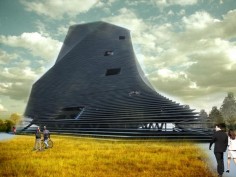SID WICHIENKUER
TU Delft School of Architecture
source: sidwich
The world is in crisis! Economies are collapsing, ecologies are failing, and global stability is threatened. If the rebuilding of the architecture school is an outward expression of the philosophy of a school this building will be a declaration that architecture will be relevant, will be involved with other academic communities in solving these dire problems, and will seek a new sense of civic leadership.
The use of section and topographies become the driving force behind this project. The building emanates from the central quad presenting to the community at its base, the library, the accumulated knowledge of the school. Similarly, the interface to the greater Delft community is a series of building laboratories where the spectacle of experimentation by the faculty and students is presented to the quad and greater school. It is intended that each these laboratories foster a dialogue and are used to build, experiment, and innovate.
By reconstituting and reconsidering each of the precedents, the resultant project intends to not reinvent but understand how section can foster productive architectural relationships.
The gathering/communal spaces are stacked through the core of the building – operating as a central gathering space for offices, studios, and the greater community as a central, unifying element that serves the same purpose for a variety of programs.
The ground level is extremely porous with the intention of capturing the interest of passerbyers and architects alike. The center of the space is the auditorium(a) space that can be configured to accommodate multiple size and varyingly public gatherings. The option remains to accommodate even the largest of gatherings as a gesture toward bringing thinkers and doers of all-calibers, whether architects or not, into the dialogue of the building.
The language of productive topographical surfaces is exploited for creating circulation, shading users, creating usable surfaces, storing objects, and seating. The resulting dense, carved space envelopes all the users of the building.
.
.
.
.
.
.
.
source: adentroyafuerawordpress
Un edificio en el que la topografía y las secciones son parte fundamental. Es la propuesta del arquitecto Sid Wichienkuer para la reconstrucción del edificio de la nueva sede de la Escuela de Arquitectura TU Delft, (Holanda) destruida por un incendio en el 2008.
En palabras del arquitecto:
Está diseñada alrededor del espacio central: la biblioteca que es la base de conocimiento, bordeada por talleres y laboratorios. Las capas crean circulaciones, sombras, superficies para diversos usos, zonas de depósitos y áreas para sentarse.
La fachada se convierte en una gran gradería.


